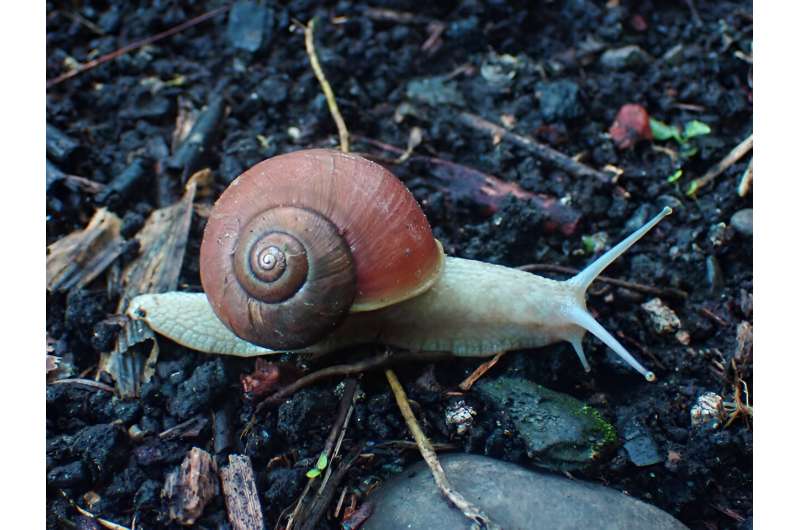
Snails often get a bad rap for being slow and inefficient and are sometimes used to express laziness. However, a team of researchers from Kyoto and Hokkaido has now revealed that snails are anything but lazy, particularly when feeling threatened. Two species of the genus Karaftohelix—K editha and K gainesi—showed opposite behaviors in response to predator-like stimuli.
In previous studies, researchers reported that K gainesi, a terrestrial snail almost endemic to Hokkaido, defended itself from its natural enemies by swinging its shell.
"Snails usually seem to escape from predators by withdrawing into their shells, but our study is the first report of a snail escaping in top gear," muses Yuta Morii of Kyoto University's Hakubi Center.
In the new study, published in the journal Behaviour, Morii's team found that K gainesi—also known locally as ezo-maimai—accelerate their forward movement by a factor of 20%–30% in response to external stimuli that mimic the predacious carabid beetle. This resulted in an average speed increase from about 1.05 mm/sec to 1.27 and 1.35 mm/sec.
K gainesi is active day and night, which is rare for snails. In contrast, its nocturnal relative K editha—or hime-maimai—retreats into its shell when responding to threats or discomfort.
"Individuality is also not a uniquely human trait," suggests Reiichi Ueki of Sapporo Keisei High School, "in that non-human animals also demonstrate this animal personality."
The significant differences in this fight-or-flight response between these snail species are evidence of closely related species expressing behavioral syndromes—a suite of correlated behaviors observed across different categories—in the process of speciation.
In the case of the snails, K editha expresses reactive behavioral syndrome, which tends to be labeled as shy and passive. On the other hand, K gainesi is proactive, and seen as bold, active, or aggressive.
"By showcasing multiple behavioral traits within the framework of animal personality and behavioral syndromes, it might be possible to understand their evolutionary processes better," says Morii.
Speaking of his research team, Morii adds, "Collaborating on a volunteer basis with expert and non-expert citizens and students has also been deeply meaningful and rewarding, especially in terms of contributing to science literacy."
More information: Yuta Morii et al, The divergence of mobility and activity associated with anti-predator adaptations in land snails, Behaviour (2023). DOI: 10.1163/1568539X-bja10249
Provided by Kyoto University
Citation: Japanese snail adaptation and speciation in anti-predation escape behavior (2023, November 27) retrieved 27 November 2023 from https://ift.tt/csGP1pW
This document is subject to copyright. Apart from any fair dealing for the purpose of private study or research, no part may be reproduced without the written permission. The content is provided for information purposes only.
"behavior" - Google News
November 28, 2023 at 01:04AM
https://ift.tt/08zpQyb
Japanese snail adaptation and speciation in anti-predation escape behavior - Phys.org
"behavior" - Google News
https://ift.tt/g8vxVhW
Bagikan Berita Ini














0 Response to "Japanese snail adaptation and speciation in anti-predation escape behavior - Phys.org"
Post a Comment